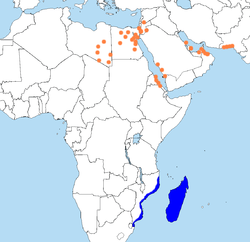Hunting behaviour
During winter the falcons hunt alone, in groups or even as flocks of up to 15 individuals. These hunting flocks tend to perch on trees and feed on swarming insects. During the breeding, summer, season males do the majority of the hunting. Four hunting techniques are employed: (1) Diving from a perch. The falcons spot prey from their perch and then dive bomb and catch it. (2) Flushing. Flushing is a technique used in which falcon individuals fly low over bushes or trees in an attempts to flush other birds out, after which they catch them. (3) Flying up to come down. When a falcon spots a flying prey bird they try to fly further above it, and then dive down to intercept the prey. (4) Survey flight. Individuals circle areas at great heights in hopes of spotting a prey item. Once prey is spotted the falcon flies down below the prey, and then turns back up into the prey's flight path to catch it. [6]
Nesting and breeding behaviour
Sooty Falcons lay eggs during mid-summer, and unlike most other falcons, occasionally nest in colonies. The falcons breed in the arid deserts of Southwest Asia and North Africa during the summer months, which is remarkable due to high summer temperatures. They breed in three types of arid environment: (1) small islands in the Red Sea, (2) mountainous deserts and (3) in deserts with rocky outcrops. It nests on a ledge or on rocks, laying up to four eggs. [5] While the falcons tend to nest on high cliffs, they have also been found nesting between rocks or on the ground. Nests are scraped into soft limestone, chalk or sandstone cliffs, and face away from the sun to provide shelter from its rays. Nest also function as perches from which defense against predators is mounted. [6]
Birds begin to display and mate during April and May, with eggs being laid by July-August. Egg incubation lasts approximately 27-29 days. Incubation is predominantly performed by the female, while the male only taking shifts for 1-7 minutes while the female sunbathes. Males hunt and bring food to the female and chicks once they have hatched. During the incubation period males provide females with 3-4 birds per day. Excess food is cached on shaded ledges outside the nest. Doing this ensures that food is regulated and that it is available when it is scarce. It also keeps the nests clean, and prevents parasites and pests from being attracted to the nests. The young falcons remain in the nest for 32-38 days, after which they still remain near the nest for a further 2-3 weeks. During this period the parents still take care of them, but thereafter the level of parental care begins to decrease. [6]
Birds nesting on islands in the Sea of Oman have a mean clutch size of 2.83 and brood size of 2.11, with 12% of nests failing at the egg or nesting stage. [7]


